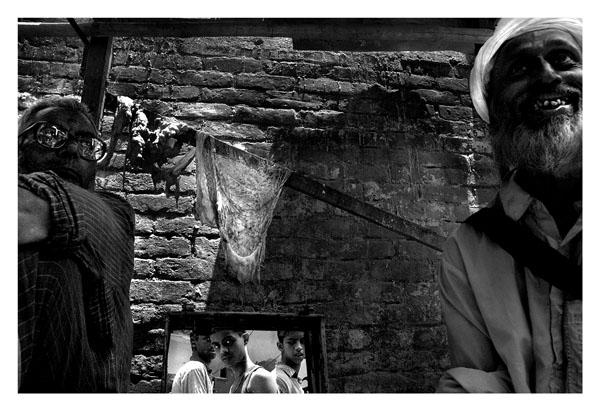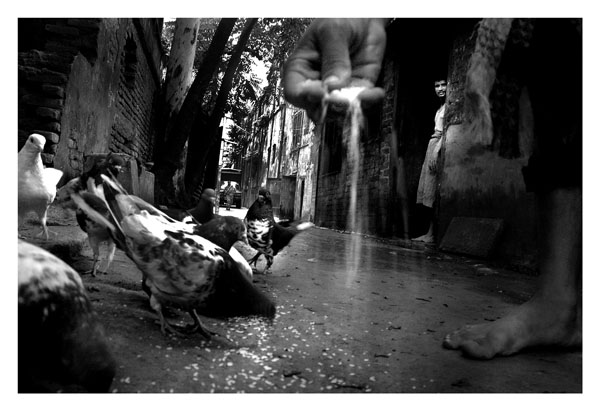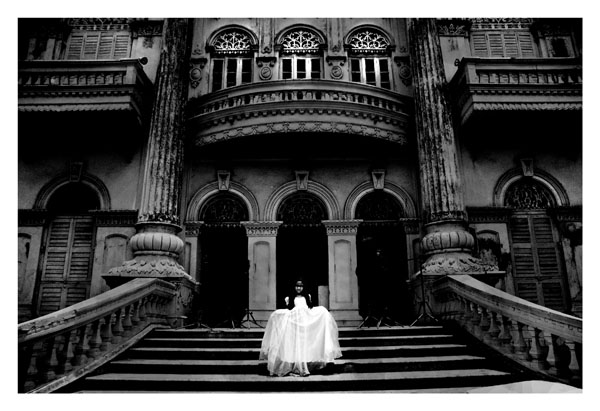![]()
![]()
Pathshala, The South Asian Institute of Photography celebrates its 10th anniversary
Elita Karim
Star Weekend Magazine Volume 7 Issue 5 February 8 2008
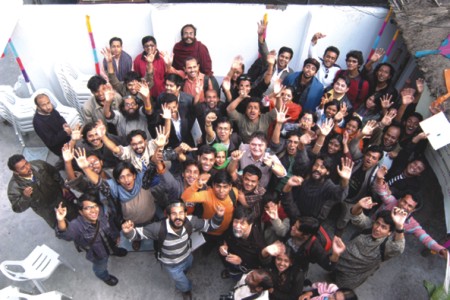 ?D. M. Shibly
?D. M. Shibly
Members of the Pathshala family have a lot to celebrate. ?My son had once written an essay in class, where he wrote that his mother is a photographer,? says Munira Morshed Munni, freelance photographer, photo editor at Drik News and teacher at Pathshala. She is also one of the first students of Pathshala, and has been with the school for the last ten years. ?His teacher, upon reading the line, immediately cut it out, assuming it to be a mistake made by the child. Later on, I had to go speak to her and explain that I really am a photographer and also make a living out of it. She was dumbstruck for a while.? You can’t blame the teacher, adds Munni. It is still very difficult for the society to accept this art-form as anything but a hobby, a side interest or a skill that is more or less limited to documenting wedding receptions or capturing nice images. Most people are unaware of the detailed calculations made by the seasoned photographer, of the possible number of angles that can be used for one shot, or the analysis of composition, frame and subject in the blink of an eye.
 Left to Right ? Saikot Majumder, Sazzad Ibne Syed, Abir Abdullah
Left to Right ? Saikot Majumder, Sazzad Ibne Syed, Abir Abdullah
Pathshala, The South Asian Institute of Photography, located on Panthapath, has played a pivotal role in the last decade, in changing the social attitude towards photography as a profession. Offering basic and advanced levels courses in this field, the institution also offers diploma and Bachelor equivalent courses to students. Very soon, a Master’s level programme will also begin in collaboration with the University of Liberal Arts. The school is also a part of the upcoming regional Master’s programme between universities in Bangladesh, China, Indonesia, Nepal, Norway and Pakistan.
Back in 1998, Pathshala had begun as a part of a three-year World Press Photo educational initiative in 1998. As the name Pathshala symbolises the ancient education system held in the open air, under the shade of a tree, free from the confining walls of a classroom, the institute emphasised on not merely conventional teaching the students. It allowed students to ask questions and develop their own style and perspective. The school was designed in a way that leads students to experience knowledge beyond the confines of the discipline.
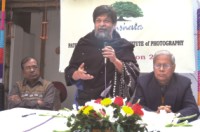 Dr. Shahidul Alam speaking on the institute’s anniversary ? D. M. Shibly
Dr. Shahidul Alam speaking on the institute’s anniversary ? D. M. Shibly
According to Shahidul Alam, the Principal of the school and MD of Drik, Pathshala strives to do much more than teach photography. ?It is about using the language of images to bring about social change. It is about nurturing minds and encouraging critical thinking. It is about responsible citizenship. In a land where textual literacy is low, it is about reaching out where words have failed. In a society where sleek advertising images construct our sense of values, studying at Pathshala is about challenging cultures of dominance.? Dr. Shahidul Alam speaking on the institute’s anniversary. According to Alam, in the South Asian region, the need for a structured education in photography has always been felt. Since photography plays a significant role in the mainstream media, this need is mostly felt in the field of photojournalism. ?The people’s right to information is generally not recognised by the official media in many countries,? he says. ?This is clearly also true for the SAARC (South Asian Association for Regional Co-operation) nations. The lack of sufficient professional skills in the media, especially in the field of photojournalism, has also allowed successive governments to pass on propaganda in place of news, and the people’s role in governance has been totally ignored.? Interestingly enough, most students, who go to this school, are studying subjects like Engineering, Medicine, BBA at other universities to comply with the conventional social mindsets. There are some, however, who end up choosing between passion and tradition, hence letting go of the so-called educational system approved by society. One such student is Azizur Rahman Peu, editor of Drik News, teacher at Pathshala and also one of the first students to have entered the school ten years ago. ?I was studying medicine in Rongpur,?he says, ?when I practically ran away from home to Dhaka. I wanted to be a journalist. Back then, I didn’t know how one would define a journalist. I used to think that a photographer was, obviously, what described a journalist, capturing and documenting moments in history. My love for photography, eventually, led me to start studying here at Pathshala.? Pathshala’s certificate awarding ceremony. Blaming not only the social net, but also the media in Bangladesh, students claim that even inside newsrooms, photographers are not given their worth. A photograph tells a story as well, which should complement the journalist’s written work, rather than act as a side support. ?Newsrooms have news editors,? says Shahidul Alam. ?However, the concept of a photo editor is not seen in newspaper offices here.? According to Alam, it was the Independent in the UK which had practically revolutionised the way photographs were used in newspapers, hence breaking the system. ?Other newspapers like the Guardian had to eventually accept this idea as well.? Pathshala also has regular academic exchanges between Oslo University College in Norway and Edith Cowan University (ECU) in Australia. It is not really an exchange programme, since students from these countries come to Bangladesh to learn about photography and not the other way around, adds Alam. However, this provides Pathshala students an opportunity to share experiences with students of very different backgrounds. ?The long-term partnerships with Sunderland University, Bolton University and the Danish School of Journalism, offer educational opportunities for students with other world class institutions. The internship opportunities at Drik, Chobi Mela and Drik News offer on-the-job training that is invaluable in professional life. The regular participation in international festivals and workshops provide a world-view essential to becoming established in the global marketplace. And then there is the acid test. Emerging students are in demand, and ever since Pathshala started, all students who have graduated are gainfully employed. Some are already at the very top of their profession,? says Alam. Celebrating a decade with fireworks. Norman Leslie, the programme director from ECU, says that his students have had the chance to experience life in all its reality and colours through this exchange programme. ?ECU is located in Perth, which is a city extremely isolated even in Australian terms,? says Norman. ?Students from this university, besides having the advantages of international exposure through this programme, have also created a certain bond between the two cultures which is extremely important when it comes to the art of photography.? Even though passionate about art and photography from an early age, Shahidul Alam had decided to take up photography as a profession by accident. Back in the 80s, Alam was doing his PhD in Chemistry in the United Kingdom. As was the norm and still is in the society, studying a proper subject define the integrity and depth of being a true man. ?And that is what my parents believed as well,? says Alam. ?I did not have much money and would work to pay my tuitions.? One of his close friends got into the airlines business and asked him to fly to the United States with him. ?A poor student like me would never get this opportunity ever again and so I decided to go. My friend in the UK asked me to bring him back a camera since cameras were cheaper in the US.? Alam got a full set complete with a tripod and lens and got back to the UK, only to find that his friend did not have the money to pay him back. ?And I was stuck with it!? laughs Alam. Pathshala recently entered its tenth year. Celebrating the school’s anniversary, a three day festival was organised where both the old and the new students presented their works, amidst other festivities.
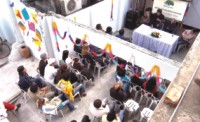 Pathshala’s certificate awarding ceremony ? D. M. Shibly
Pathshala’s certificate awarding ceremony ? D. M. Shibly
A photography exhibition titled ?Studying Life? began marked the beginning of the festival on February 1 at the Drik Gallery. Exhibiting works by some of the most celebrated students of the school, this event was inaugurated by Atiqul Huque Chowdhury and Dr. Shahidul Alam. The exhibition, which will continue up to February 15, features thirty six photographers, including Munem Wasif, Abir Abdullah, GMB Akash, Tanvir Ahmed and many more. On February 2, certificates were distributed to the students who had finished their respective courses, starting from the basic to the undergraduate level. ?We had a full-fledged festival, complete with a winter Pitha Utshob,? says Joseph Rozario, the Administrative Manager of Pathshala. ?Students, teachers, along with a few photographers from outside the country had discussions on photography. These photographers also presented some of their unique works. The day ended with a film made by one of our own students,? he says.
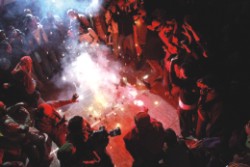 Celebrating a decade with fireworks ?D. M. Shibly
Celebrating a decade with fireworks ?D. M. Shibly
The last day of the festival, February 3, was an ?absolute blast,? according to Din M Shibly, a Pathshala graduate who now teaches at the school and works for the monthly magazine Ice Today. The highlight of the day was when Prachyanat, the musical theatre group, performed at the school, much to the delight of the students and also a number of guests who had turned up at the celebrations. The notion that photography cannot be a proper career no longer holds true. Many students from Pathshala are working in the media, both local and international. Tanveer Ahmed, student of Pathshala who now works at Drik News, recently had one of his photographs published in the Time magazine as the picture of the year. The photograph shows a grandfather carrying the dead body of his grandchild after being hit by the Sidr cyclone last year. Many other Pathshala students have won international awards. Alam says that young people believe that there is more glamour and less money in this profession. ?It is actually the other way around,? he explains. He plans to work more on visual literacy, hold workshops in schools and develop this field as an academic subject in the educational institutions in Bangladesh. Photography is much more than capturing a mere image. It is what one captures within the image; emotions, environment, thoughts, social perceptions and so on. One simply has to look into a photograph to discover these elements, rather than looking at it. As actor and author Sir Dirk Bogarde had put, ?The camera can photograph thought.?
Tag: Photography
Studying Life
![]()
![]()
10th year of Pathshala
Video on Pathshala by Brian Palmer. Commissioned by Pullitzer Foundation:
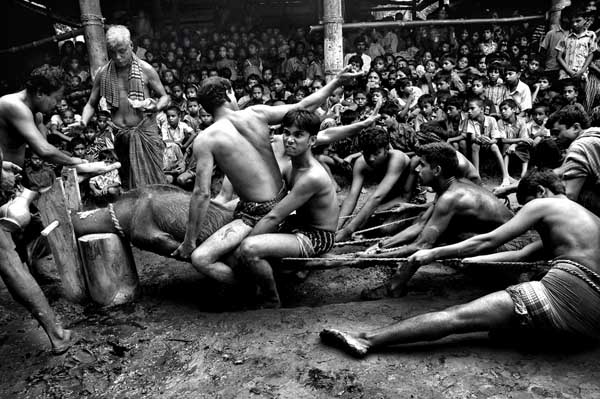 Boli. Goat being sacrificed at Hindu religious ceremony. ? Saikat Mojumder.
Boli. Goat being sacrificed at Hindu religious ceremony. ? Saikat Mojumder.
Rashid Talukder had been unwell and had excused himself. The other board members Afzal Chowdhury, Mahfuz Anam, Nawazesh Ahmed and I had pored over the crude portfolios. Much of the work was raw, but there was freshness and a vibrancy that touched us all. This new school would take risks. Ideas would be given a chance.
The students have emulated that principal characteristic of Pathshala. Reaching for the impossible has become the norm. Pushing the school and themselves to the limit has been their mode of practice. Dreaming, a way of life.
On the day of the first workshop, with World Press Photo in 1998, a hastily flung white cloth had covered up the bricks being used for the unfinished construction of the computer lab. On its tenth year, the school boasts achievements by students that is the envy of schools worldwide. The early partnerships, with World Press Photo Foundation, The British Council, Panos Institute, The Thomson Foundation and Free Voice (formerly CAF) have all played an important role, but the new liaisons, with the University of Liberal Arts in Bangladesh, and the upcoming regional masters programme between universities in Bangladesh, China, Indonesia, Nepal, Norway and Pakistan are paving the way for a school that has matured beyond its years.
The academic exchanges with Oslo University College in Norway and Edith Cowan University in Australia provide Pathshala students an opportunity to share experiences with students of very different backgrounds. The long-term partnerships with Sunderland University, Bolton University and the Danish School of Journalism, offer educational opportunities for students with other world class institutions. The internship opportunities at Drik, Chobi Mela and Drik News offer on-the-job training that is invaluable in professional life. The regular participation in international festivals and workshops provide a world-view essential to becoming established in the global marketplace. And then there is the acid test. Emerging students are in demand, and ever since Pathshala started, all students who have graduated are gainfully employed. Some are already at the very top of their profession.
But the goal of Pathshala is far more than teaching photography. It is about using the language of images to bring about social change. It is about nurturing minds and encouraging critical thinking. It is about responsible citizenship. In a land where textual literacy is low, it is about reaching out where words have failed. In a society where sleek advertising images construct our sense of values, studying at Pathshala is about challenging cultures of dominance.
Curating an exhibition of so diverse a group is always difficult. One wants to be inclusive but selective. Demonstrate trends, but value differences. Nurture new talent, but recognise excellence. Choose favorites but not be partisan. The greater importance given to some artists has as much to do with what needs to be said now as it has to do with the calibre of their work. Pathshala cannot be an academic island untouched by local realities. While recognising the merit of those producing quality work, space has also to be given to voices that need to be heard now. These are images of ‘Now’ being articulated.
Shahidul Alam
A True Pathshala
The word Pathshala, a traditional Sanskrit word for a seat of learning, was generally associated with the shade of mango trees in open fields. There were no walls, no classrooms, no formal structures, but children gathered to listen to wise folk. It was wisdom being shared.
Having decided that the language of images was the tool to use to challenge western hegemony and to address social inequality within the country, Drik had begun to put in place the building blocks to make it happen. The agency was serving people already in the trade, but opportunities for learning had to be created. There wasn?t a single credible organization for higher education in photography in the region. One had to be built. Taking advantage of a World Press Photo seminar on 18th December 1998, the school was setup. A single classroom was all that was available. The visiting tutors Chris Boot (formerly with Magnum, then with Phaidon) and Reza Deghati (National Geographic) conducted the workshops. I continued as a lone tutor. Kirsten Claire an English photographer whom a friend had recommended, came over soon afterwards and stayed for a year. We paid her a local salary, the best we could afford. The two of us formed the faculty.
A stream of tutors, all friends willing to be arm twisted, came at regular intervals. For some we provided air fare and modest accommodation. Some came at their own cost. Some slept on our floor. Some, like Ian Berry, who had come over on an assignment, were simply roped in. The students, most new to the craft, didn?t know they were rubbing shoulders with the greatest names in photography. And it was an impressive list of names. Abbas, David Wells, Daniel Meadows, John Vink, Ian Berry, Ingrid Pollard, Martin Parr, Morten Krogvold, Pablo Bartholomew, Pedro Meyer, Raghu Rai, Reza Deghati, Robert Pledge, Steven Mayes, Tim Hetherington, Trent Parke and many others had spent quality time with Bangladeshi photographers. Some had come even before Pathshala started. Some, like Robert Pledge, Reza Deghati, Abbas, David Wells, Morten Krogvold and Raghu Rai, were repeat visitors. Few demanded payment; none flaunted their superstar stautus, one even made an anonymous donation. They all wanted to be part of a very exciting journey. One or two wanted to be on the faculty to embellish their CVs, but they all gave generously, and this organization has been built on their labour of love.
Lazy at first and unaware of how special the environment was, the students soon became infected by the passion of their marvelous tutors. They studied photography, economics, statistics, environmental studies, visual anthropology. They were in a true Pathshala, studying life. And it showed. Despite the limited resources of the school, we maintained one goal we had set for ourselves at the outset. Every emerging student was gainfully employed. The trend has continued since 1998. They got selected for the prestigious Joop Schwart Masterclass. They won awards like the Mother Jones, World Press, the National Geographic All Roads and a host of other prestigious awards. Time Magazine, Newsweek, New York Times and other leading publications began to hire them, and the reputation spread. Soon students and interns from other countries began to come in. Most were from neighbouring countries, but some from far flung places like Norway, the USA and Australia wanted to join.
The number of regular tutors has grown from the original two to eleven. Eight are former students. The tutor to student ratio remains very high. DrikNews, a news agency which gives emphasis to rural reporting, hires former Pathshala students for its their core staff. The staff photographers and picture editors of most major newspapers in Bangladesh are from Pathshala. Some are also working in television stations and other broadcast media. And Pathshala continues to defy gravity. A school of photography in one of the most economically impoverished nations and with no external support, continues to produce some of the finest emerging photographers.
Shahidul Alam
The school of photography Pathshala, is entering its tenth year. Greetings to all students, teachers and well-wishers who have journeyed with us over the last nine years. An exhibition “Studying Life” featuring the work of Pathshala students and alumni will mark the beginning of our celebrations.
Pioneer playright and theatre person Atiqul Huque Chowdhury will inaugurate the exhibition on 1st February 2008 at 5:00 pm at Drik Gallery.
The exhibition will continue till 15th February 2008 and will be open to all from 3:00 pm till 8:00 pm.
You are invited.
Inauguration date: 1 February 2008
Time: 5:00 pm
Exhibition duration: 1 February – 15 February 2008 (3-8 pm. every day)
Venue: Drik Gallery, House 58, Road 15A (new), Dhanmondi Residential Area, Dhaka.
Programme:
1 February 2008
5:00 pm, Drik Gallery
Opening of photography exhibition “Studying Life”
2 February 2008
Pathshala Campus (16 Sukrabad, Panthapath)
3:00 pm: Certificate Distribution
3:45 pm: Discussion on Photography
4:30 pm: Portfolio Presentation
5:15 pm: Film Show
3 February 2008
Pathshala Campus (16 Sukrabad, Panthapath)
2:30 pm: Portfolio Presentation
6:30 pm: Songs by Prachyanat
8:30 pm: Dinner
Selected photographs from the exhibition can be seen in the Drik 2008 Calendar:
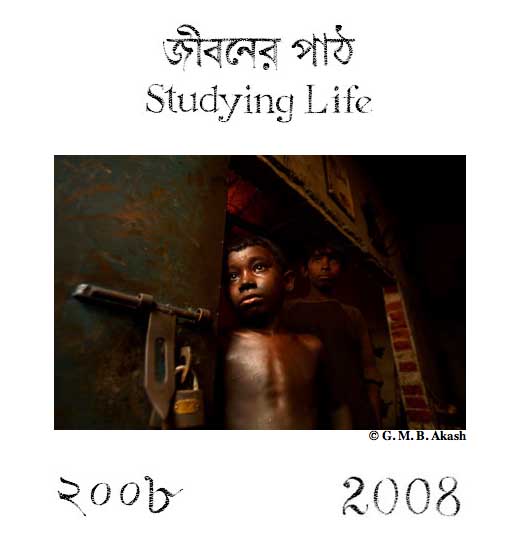
Submissions are invited for Chobi Mela V. The theme is “Freedom”. The online submission form will be available at www.chobimela.org from the 7th February 2008.
The Game of Death
![]()
![]()
She may well have been the best leader available. With a military dictator and a corrupt businessman as the alternatives, Benazir Bhutto, with her western admirers and her feudal followers, was clearly a front-runner. How she died will probably remain a mystery, but she was playing the game of death, and it was unlikely she would win every time.
It is difficult to write about people who have just died. Many are grief stricken at the untimely death of the former prime minister. Even her critics are shocked by the way she was hunted down. An insensitive piece would aggravate their pain, and one doesn’t generally speak ill of the dead. I remember as a child asking my mother “Amma. Do bad people never die?” A man not known for his strength of character had died, and newspaper reports had described him as an honest social worker. I am no longer of the age to get away with such questions. But even for those who have loved Benazir, I believe the questions need to be asked if this cycle is to ever stop.
It was 1995. They were troubled times in Pakistan. I had gone over to Karachi on the invitation of my architect friend Shahid Abdulla. There were no telephone booths at Karachi airport, or anywhere else in the city. The government was worried the MQM would use them for their communication. Sindh was at war with itself.
Shahid wanted me to run a photography workshop at the Indus Valley School of Architecture and Design that he was involved in. Those were the days when we had time for long conversations. We talked of many things. The gun-toting security men outside every big house in Karachi. Shahid’s meeting with Zulfiqar Ali Bhutto. His memories of Benazir. But the conversation would often veer to a person we both admired. Abdus Sattar Edhi, the humanitarian who had set up an unparalleled ambulance service all over Pakistan.
On the morning of the 10th October, I went over to see the man. He had an easy charm that came from living a simple life and having little to hide. He sat on his wire mesh bed, talking of how things started. We were regularly interrupted by people coming in with requests, and Edhi responding to minor crises. Then we heard about Fahim Commando the MQM leader, having been killed. Fahim and his comrades had apparently been caught in an ambush and all four had died. They had been in police custody, but the police had all escaped and not one of them had been injured. Edhi was not judgmental. Fahim was another man who needed a decent burial. As I watched him bathe the slain MQM leader, I could see the burn marks on the bullet holes on the commando’s body.
 Abdus Sattar Edhi, bathing Fahim Commando. Karachi. Pakistan. 10th October 1995. ? Shahidul Alam/Drik/Majority World
Abdus Sattar Edhi, bathing Fahim Commando. Karachi. Pakistan. 10th October 1995. ? Shahidul Alam/Drik/Majority World
The extra-judicial killings during Benazir’s rule are well documented. The fact that no investigation was done when her brother Mir Murtaza was killed outside Bilawal House, the family home, fueled the commonly held belief that her husband Asif Zardari had arranged the killing. Even Edhi’s ambulances had not been allowed access. Not until Murtaza had bled to death. Anyone who witnessed the murder was arrested; one witness died in prison. Benazir was then prime minister.
Murtaza had been vocal against the corruption of Zardari. Benazir defended her husband stoically throughout. Despite the Swiss bank accounts, she assured people that he would be seen as the Nelson Mandela of Pakistan. With Zardari now tipped as the new chief of PPP, Pakistan’s Mandela and his Swiss bank accounts might well be the new force. Whether Pakistanis will see this polo-playing businessman as the saviour of the day remains to be seen.
Supported by the US, Zulfiqar Ali Bhutto had been largely responsible for the break up of Pakistan and the genocide in Bangladesh. The current string pulling by the US has hardly made Pakistan a safer place. The western support of militarisation in Bangladesh and the growing importance of Jamaat is an all too familiar feeling. If Pakistan is an omen, it is a sinister one.
Perhaps Mrs. Packletide would have known how the former prime minister of this nuclear nation died. But the government’s attempts to cover-up will do little to quell the conspiracy theories. Like the Bhutto family, the military too have burned a lot of bridges in getting to where they are. There are too many skeletons in their closet. There is no going back, and no price too high.
What the World Eats
As colleagues are out there trying to? provide relief to the people affected by cyclone Sidr. As I talk at my book launch of “Nature’s Fury” in Glasgow. The mail from Kenneth Van Toll reminding us on World Human Rights Day, of the disparity in people’s lives provides food for thought.
The people of Bangladesh have some of the lowest ecological footprint in the world, but they are the ones who will pay the price for the effects of? the world’s biggest consumers.
—–
Today, poverty prevails as the gravest human rights challenge in the world. Combating poverty, deprivation and exclusion is not a matter of charity, and it does not depend on how rich a country is.
By tackling poverty as a matter of human rights obligation, the world will have a better chance of abolishing this scourge in our lifetime…Poverty eradication is an achievable goal.Louise Arbour
UN High Commissioner for Human Rights
?What The World Eats
??? ??? ??? ??? ??? ??? ??? ??? ??? ??? ??? Beth Hartford-DeRoos
Germany : The Melander family of Bargteheide
Food expenditure for one week : 375.39 Euro or $500.07
Favorite foods : fried potatoes with onions, bacon and herring, fried noodles with eggs and cheese,
pizza, vanilla pudding
United States : The Revis family of North Carolina
Food expenditure for one week : $341.98
Favorite foods : spaghetti, potatoes, sesame chicken
?
?
Japan : The Ukita family of Kodaira City
Food expenditure for one week : 37,699 Yen or $317.25
Favorite foods : sashimi, fruit, cake, potato chips
?
?
Italy : The Manzo family of Sicily
Food expenditure for one week : 214.36 Euro or $260.11
Favorite foods : fish, pasta with ragu, hot dogs, frozen fish sticks
?
?
Great Britain : The Bainton family of Cllingbourne Ducis
Food expenditure for one week : 155.54 British Pounds or $253.15
Favorite foods : avocado, mayonnaise sandwich, prawn cocktail,
chocolate fudge cake with cream
?
?
Kuwait : The Al Haggan family of Kuwait City
Food expenditure for one week : 63.63 dinar or $221.45
Family recipe : Chicken biryani with basmati rice
?
?
Mexico : The Casales family of Cuernavaca
Food expenditure for one week : 1,862.78 Mexican Pesos or $189.09
Favorite foods : pizza, crab, pasta, chicken
?
?
China : The Dong family of Beijing
Food expenditure for one week : 1,233.76 Yuan or $155.06
Favorite foods: fried shredded pork with sweet and sour sauce
?
?
Poland : The Sobczynscy family of Konstancin-Jeziorna
Food expenditure for one week : 582.48 Zlotys or $151.27
Family recipe : Pig’s knuckles with carrots, celery and parsnips
?
?
United States : The Caven family of California
Food expenditure for one week : $159.18
Favorite foods : beef stew, berry yogurt sundae, clam chowder, ice cream
?
?
Egypt : The Ahmed family of Cairo
Food expenditure for one week : 387.85 Egyptian Pounds or $68.53
Family recipe : Okra and mutton
?
?
Mongolia : The Batsuuri family of Ulaanbaatar
Food expenditure for one week : 41,985.85 togrogs or $40.02
Family recipe : Mutton dumplings
?
?
Ecuador : The Ayme family of Tingo
Food expenditure for one week : $31.55
Family recipe : Potato soup with cabbage
?
?
Bhutan : The Namgay family of Shingkhey Village
Food expenditure for one week : 224.93 ngultrum or $5.03
Family recipe: Mushroom, cheese and pork
?
?
Chad : The Aboubakar family of Breidjing Camp
Food expenditure for one week? : 685 CFA Francs or $1.23
Favorite foods : soup with fresh sheep meat?
Bangladeshi photographers win yet again!
![]()
G.M.B.Akash a student from Pathshala’s first batch wins first prize for his photo titled “Passengers without Ticket” in the prestigious Gordon Parks Photography Competition 2007. More work by Akash can be seen at www.majorityworld.com and www.gmb-akash.com.

Other winners include “A woman standing by her paraplegic husband” by Lisa Wiltse (2nd place)

“Touch of protection” by Olivier Asselin (3rd place)
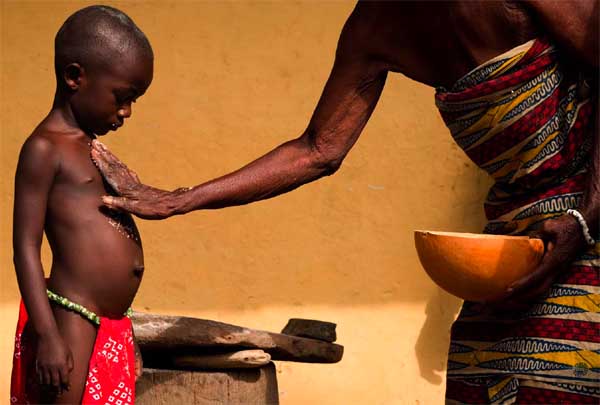
“Loss” by Chris Zuppa (honorable mention)

Mom and me by Kenny Felt (honorable mention)

and “New Citizen” by Jim Gehrz (honorable mention)

More news on the contest available soon from www.gordonparkscenter.org The video of Chobi Mela IV can be seen at: http://link.brightcove.com/services/link/bcpid1213900621 The video “In Search of the Shade of the Banyan Tree” can be seen at: http://www.brightcove.tv/title.jsp?title=1237905984 Thanks to Oliver and Angilee and UCLA International Institute for uploading the video, Asfia for the Banyan Tree song and to the large number of people who helped in the production of the videos.
Bangladeshi photographers have consistently shone internationally. Yet photography remains neglected by the Bangladeshi government. A bill passed in parliament in 1989, to open a department of photography in “Shilpakala Academy” the academy of fine and performing arts, has yet not been implemented. Even “Charukala Institute” the department of fine arts, lacks a photography course. Yet Dhaka is rapidly becoming one of the major capitals of photography and Chobi Mela, the festival of photography held in Dhaka is one of the major events in the Asian media calendar. It has often been the case that artists have only been recognised in our own soil once they have received international acclaim. Sadly, even outstanding international perfomance in the field of photography, does not appear to have woken up the fossils in the Bangladesh secretariat.
PHOTOGRAPHIC STORYTELLERS
![]()
MAKING CONNECTIONS: PHOTOGRAPHIC STORYTELLERS FROM AROUND THE WORLD
SHAHIDUL ALAM, CHRIS RAINIER, AND THE NATIONAL GEOGRAPHIC SOCIETY’S ALL ROADS AWARDEES
The National Geographic Society’s All Roads Film Project recognizes and supports indigenous and underrepresented storytellers from around the world who are documenting their changing cultures and communities through photography and film. For the third consecutive year of this popular program, we present talented artists from Israel, Kashmir, Lapland, Mongolia, Nigeria, and the United States who have been selected by the National Geographic Society to present their work and reflect on ways their images and stories make connections that help create a more just and beautiful world. The All Roads photographers will be joined by Chris Rainier of the National Geographic Society and photographer Shahidul Alam, media activist and founder of the Drik photo agency in Bangladesh.

2007 Awardees
Altaf Qadri (Kashmir)
Kashmir: Paradise in Pain
Oded Balilty (Israel)
Along the Lines
Akintunde Akinleye (Nigeria)
The Troubles of a Blessed Country
A Yin (China, Inner Mongolia)
Highland Mongolian Life
Munem Wasif of Pathshala, received an honourable mention for his photo essay “Belongings”
Monday, October 1, 2007
7:30pm
Kresge Auditorium
FREE AND OPEN TO ALL
Doors open at 6:00pm. Seating is limited, so please arrive early.
Please forward this announcement to anyone who may find it of interest.
Click here for more information about this event.
UPCOMING AURORA FORUM PROGRAMS
An Evening with Leonard Cohen and Philip Glass
Monday, October 8, 7:30pm in Memorial Auditorium
Free and Ticketed
>>ALL TICKETS HAVE BEEN DISTRIBUTED<<
For more information on these and other
Aurora Forum programs, please visit our website:
auroraforum.org
Aurora Forum at Stanford University
650.725.5633
http://auroraforum.org
The South Takes The Picture
![]()
New Internationalist editor Dinyar Godrej?s email asking us to participate in the 400th issue of the magazine a few months ago was a great opportunity. But with Dhaka in flames and our own struggles to ensure some semblance of fairness in the elections, we passed it on to other activists.
Vanessa Baird?s subsequent email suggesting an issue of the New Internationalist based on our organization ? the Drik photo agency and Pathshala photography school ? as an example of how some of us in the Majority World are challenging the global information flow, came as an unexpected reprieve.
Our immediate political problems in Bangladesh hadn?t gone away. A tribal activist had been brutally killed by the army, and a journalist friend who had been courageously reporting on military misrule had been picked up in the middle of the night.
So things were far from easy on the home front, but writing about, and showing, what had been our central struggle over the last 20 years was an opportunity we couldn?t miss. We had all lived it. More importantly, with our majorityworld.com site up and running and slowly beginning to get pictures into print, we weren?t just talking about change. We were witnessing it taking place.
This issue of the magazine could hardly have been better timed. Majority World photographers embraced the idea: from the small studio of VAST ? a voluntary artists association in Bhutan ? to a crammed office room in Santa Cruz, Bolivia; from the enthusiastic Photo Circle in Kathmandu to a hotel lobby in Dili, Timor Leste.
Our FTP site has been busy and the pictures ? some of which are featured in the pages of this issue ? have been flowing in. After years of trying to persuade others, Majority World photographers have taken things into their own hands. Watch this space.
Shahidul Alam, Drik/Pathshala for the New Internationalist Co-operative
—————————————————————————————-
The above editorial had been written several weeks ago, but the magazine has just hit the stands. Links to the PDFs of the magazine follow. The online version should be up on the NI site in about six weeks.
26th July 2007. Manila.
ni403cover.pdf
01.pdf
new-internationalist-majority-world.pdf
Tales From a Globalising World
![]()

Photo: Philip Jones Griffiths
Tales From a Globalising World
Before the white man took black slaves across the Atlantic, before the Romans marched their armies across Europe, before Mohammed, Jesus, Buddha and Krishna brought new meanings to our lives, people had reached across the boundaries of their known world to reach for the unknown. They searched for power, for wealth, for salvation for escape. Though the world has changed the forces are largely the same. Photographers, the modern day storytellers, tell the tales of these new journeys. Ten photographers from different nations and different sensibilities take us along their routes. They hold our hands, for we are all strangers in this slippery and winding path.
They talk of promised lands and unrealized dreams. Of struggles, triumphs and contradictions. Of unseen poverty and empty glamour. Of wounds that have healed and of new forms of enslavement. Of mixed identities and changing fortunes. Globalization is not new, and colonialism is not dead. The search for roots competes with the search for utopia. But In a world where new fears give rise to new forms of oppression and corporate interests create the new rules of engagement, fragments of memory compete with visions of imagined futures while reality in its many forms, across nations and across cultures, continues to shape our lives. Through tender, provocative, abstract and sometimes brutal images, through lost childhoods and regained lives, through dense ghettos and lonely faces, through found mementos and anonymous production lines, through images of hope and visions of despair, the storytellers of today remind us of the invisible threads that connect us all.

Photo: Andreas Seibert
ANDREAS SEIBERT
Somewhere from Nowhere
China, Pearl River Delta: 21st-century megalopolis
They once had dreams. Huddled at dusk into the back of a truck that appears to move into the night, they?ve traded their dreams for the harsh realities of makeshift homes. They build boutiques, condominiums, fancy homes for fancy people. They will never enter the homes they build or shop in the fancy malls. Their only chance to enter the condominiums is as a domestic servant or as a delivery boy. The dream of the big city where the streets are paved with gold only survive in the electronic TV screens in cramped dorms. There is a certain universality in their existence. The stark faces lit in the cool neon lights in Andreas Seibert?s rendering of migrants in China?s Pearl River Delta, have an eerie resemblance to the faces in the sweatshops in Europe. The man crossing the barren field to the tenement squares could easily be songwriter Ralph McTell?s old woman in London:
She’s no time for talking
She just keeps right on walking
Carrying her home in two carrier bags

Photo: Thomas Kern
THOMAS KERN
Homeland of Globalization
USA: from Detroit to the Mexican border
They had talked of a world without borders. Of freedom for all. Of opportunities unlimited. But the mobility of people did not parallel the mobility of goods. The notions of freedom do not apply equally to all nations, the search for freedom changes into the quest to protect ?American Values?. Huge inequalities across borders and between communities create isolated groups that find more solace in guns and the cross than in reaching across barriers of class and race. Factory floors transform people into robots. The champions of consumerism come face to face with poverty and discontent. The glitter of Las Vegas loses its sparkle in the relief queues in black neighborhoods. Amidst the rhetoric and the slogans, through the memorials and the sit-ins, the biggest war machine in existence searches blindly for peace. Wrapped in the metaphor of the American flag, they continue to ask ?Why do they hate us?? without once stopping to look at themselves.

Photo: Cristina Nu?ez
CRISTINA NU?EZ
Made in Italy
Italy, Milan and Naples: parallel worlds of fashion
They tell us what to wear, how to look, what to feel. They shape our desires. Anorexic women tread waiflike along catwalks as if suspended in space. Swirling amidst the popping flashlights, they walk in measured gait. In calculated gestures, they cast vacant glances, looking into space. Celebrities and brand names team up to create a make belief bubble that longs to be touched but is never within reach. It is a world within itself, celebratory, narcissistic, trend setting. Back in the dressing room, the make-belief world slowly merges with reality. Peeling off layers, Nu?ez strips down the mask to reveal the world beneath. The sweatshops, the hopefuls and the also-rans switch between the real world, the fake world and the make belief world in no particular order for the borders are often blurred.

Photo: Stephan Vanfleteren
STEPHAN VANFLETEREN
Facing Stories
Belgium: the poverty of loneliness
GDP, GNP, per capita income. These are the measuring sticks of progress. First world, second world, developing world the tiers of development. As nations strive to move up the value chain to greater wealth and greater prosperity, they leave behind the fabric of human connectedness that bind our souls. The second car becomes more important than the time spent with a friend. Not everyone makes it to the speeding train of progress. Some fail to catch it, some step out willingly, some slip off the packed rooftops. But it is a speeding train, and once it goes by, is difficult to stop. The ladder of success has rules of engagement, and those who fail to understand the rules, never make it to the goalposts. They dream, they love, they despair, they cling to familiar haunts, to known friendships. Lonely friends unite in their solitude, be it drugs, a lover, a pet, an old harmonica.

Photo: Shehzad Noorani
SHEHZAD NOORANI
Childhood Denied
Nepal, India, Bangladesh: struggle to survive
The child is lonely in a crowd. The island in the middle of a busy road offers a brief respite, but hunger gnaws away, and work must begin. The employment differs, from cleaning kitchens near the fish market, to satisfying men with a hunger for more than food. The train station, the local brothel, the dock, the crowded slum, offers shelter, sometimes food, but always demands something in return. It is an equation they have learnt early and is far more real than the maths equations which they will never learn. They leave homes, friends, family, sometimes forever, returning perhaps only to die. Race, religion and class and all other tools of social oppression, combine to ensure that those born poor will die poor. Like the snail without a shell they wander through life, moving from ?uncles? to ?husbands? to ?masters? and ?bosses?, accepting whatever is dished out to keep the hunger away for another day.

Photo: Ziyo Fafic
ZIYO GAFIC
Quest for Identity
Bosnia-Herzegovina: recovery from war
Sombre clouds over dense mountains. Square pictures saturated in colour. Neat rows of coffins, bodies of the only ones recognisable after the genocide. A comb, a watch, an old note, dentures, bent spectacles. How does one represent war? What is the image of bereavement? What colour is pain? For a young man who has been through war, it is a difficult portrait to paint. But Ziyo Gafic paints it with muted light. Unsentimental, but tender, he observes from within. It is not only grief that he photographs, but survival. Muslim but white, European but Muslim, white but poor, Gafic takes on the dilemma of his identity and gives it form. The solidity of a bridge over placid water. The luminescence of transparent plastic bags over dense foliage carrying the remains of known ones. The earthiness of digging a grave, the silence of a morgue, the weightlessness of objects of everyday use, form the background of his tapestry. But through it all the carefree leap of a child, defying gravity, exuding joy, remains a lasting image.

Photo: Tim Hetherington
TIM HETHERINGTON
Healing Sport
Angola, Liberia, Sierra Leone, Kenya: ways out
The weather-beaten fingers hold the ball firmly. A torn scarf, strings tied together and bits of cloth make up this football. Small and not quite round it is held as it should be. A prized possession. Bob Kpwilo of Millenium Stars Football Team (formerly Power from Heaven), stands in the middle of the field, the sweat on his dark skin glistens in the soft light. They are footballers. Masters of takwondo. Sometimes they are glue sniffers, or child soldiers, or all of them at once. In bare classrooms and overcrowded cities, they practice sport in the shadows of war. The children are pawns of competing warlords. The countries are pawns of wealthy nations. To slave traders, gold miners and oil diggers, Africa is just a pawn. But these children want to play a different game. They have been torn from their parents, wounded in battle, blown up by mines. They have been raped. They have raped, they have killed. But these are games they will no longer play. With wooden limbs, blinded eyes and scarred minds, they?ve chosen sport as their answer. They?ve chosen games without pawns.

Photo: Bertien van Manen
BERTIEN VAN MANEN
Paradise in Boxes
France: immigrants in the Paris suburbs
They generally stare at the camera. Young children, couples, families wearing their best clothes. Young men in football gear. Propped up on the mantelpiece, or held against the favourite carpet. Sometimes it is a photograph of their home, or their wedding day, or their identity card with a faded photograph. Lodged between teacups or stuck on a window, they show different realities. Lives they have found and lives they have left behind. Which is more real? Who is the man through the broken glass? What are we looking at, the photograph on the windowpane or the Parisian cityscape beyond? The flare from the flash bounces rudely off the print. The prints stuck between a gilded frame and the wallpaper compete for attention with the artifacts of living. The duality of these images plays on the duality of their existence. Here, there, now, then, before, after. A self exiled existence that rarely turns out the way it was planned. A choice that was not really chosen.

Photo: Philip Jones Griffiths
PHILIP JONES GRIFFITHS
Independence and Transition
Vietnam: values, old and new
They put poison in their fields. Mothers still bear children with twisted limbs and enlarged heads. They still die of cancer. Between 1961 and 1971 the US military used the herbicide Agent Orange in Vietnam. On March 10 2005, judge Jack Weinstein dismissed the lawsuit filed by the Vietnamese victims of Agent Orange. No Vietnamese have ever received compensation for the damages they have suffered. But the country has changed in many ways. A giant bill-board hovers over a paddy field, towering above a farmer with her bamboo hat. For Philips Jones Griffiths, the author of Vietnam Inc., the signs of westernisation give mixed signals. Belly dancers, mobile phones and yuppie kids might show a Vietnam moving west, but Griffiths also sees the other side of the coin. The mannequins modeled on western features and urban poverty as farmers are pushed into the cities show the erosion of value systems that capitalism threatens to destroy.

Photo: Akinbode Akinbiyi
AKINBODE AKINBIYI
Black Atlantic Divinities
Nigeria and Brazil, Lagos and Brazilia: migrant gods and returnees
They embraced all the gods. Their ancient ones, the ones of their brothers and sisters under oppression, even the ones of their oppressors. Moving across the ocean, the music, the architecture, the culture, the religion, fused into one. Three centuries of slave trade have created a bond across continents. The African beat and the colours of Brazil, immerse in each other. The chaos, the vitality, the fervour, the passion all become one. Yoruba, Candombl?, Umbanda, three religions with blurred borders, protect the mixed communities on either side of the Atlantic. The collective gods punish evildoers and the insolent, but also protect motorcars, overlook wars and ensure justice and creativity. The shrines, the rituals, the symbols, the art, are preserved in the mixed cultural roots of the Africans of the west coast and Brazilians. Their bondage has led to a shared sense of divinity. They dance and they pray together. Out of the darkness came light.
Shahidul Alam
7th July 2007, Dhaka

Photo: Md. Mainuddin/Drik
Tales From a Globalising World exhibition being packed at Drik Gallery in Dhaka for shipping to La Paz, Bolivia.
————————————————————————————————————————————–
Drik Gallery presents
30 years of photojournalism: Manoocher Deghati

Photo: Manoocher Deghati
In the summer of 1978, Manoocher Deghati educated as a filmmaker, returned to Iran after three years of studies at the Rome school of cinema just as the first major demonstrations against the regime of the Shah were breaking out. He decided to photograph these events. “I remember going out the first day with a camera in hand. There was a great deal of agitation. A truckload of soldiers rolled by. One of them loaded his rifle and fired at me. The burst of bullets passed on either side of my head. I was alive. I was shocked. But above all, I realized that I was a target because I was taking pictures. That only reinforced my determination to take pictures.”
In 1979, the Sipa Press agency had asked him to become a permanent correspondent in Iran. Manoocher photographed all the big events of the new regime of Khomeini, the hostage crisis at the American embassy and the Iran-Iraq war, which he covered for six years. Currently he is the head of IRIN Photo, the United Nations’ News Agency, and lives in Kenya
Manoocher Deghati will present his work on the 18th July 2007 at 6:00 pm at the ULAB Campus Auditorium. Manoocher will also talk about his work with Afghani photographers at AINA Media Centre in Kabul.
Auditorium
4th floor ULAB Campus
House 56, Road 4/A
Dhanmondi Residential Area
Dhaka
National Geographic Honourable Mention
![]()
Munem Wasif’s photo essay “Belongings” receives Honorary Mention at National Geographic All Roads.
source: 1st June 2007
Chris Rainier & Eduardo Abreu
All Roads Photography Program
http://nationalgeographic.com/allroads
Interview on Uprising Radio:
http://uprisingradio.org/home/?p=1577
Old Dhaka-Belonging
![]()
Farish had talked of situations “so full of all qualities of
loveliness and purity, such new regions of high thought and feeling?
that to the dwellers in past days it should seem rather the production
of angels than of men.” Madras Christian Instructor and Missionary
record (1844).
The Baroque music in the forests of Bolivia, did indeed sound like the
production of angels. Cecilia had brought us all over during the “VI
Festival Internacional de teatro Santa Cruz”. The church itself was
quite beautiful. Helmut’s comment, “At least the church did something
good”, rang in my ears. I see this beautiful land, one of the few in
South America where the indigenous people haven’t been largely
decimated. I see extermination of their religion, their language and
struggle to see how it was all dressed as civilization. I see the
ornate walls of the grand church and listen to the untold stories
screaming to be heard.
Thousands of miles away, a young Bangladeshi photographer Munem Wasif,
gives up the ‘respectable professions’ chosen for him and decides to
be a story teller. The third Pathshala alumni to be selected for the
prestigious Joop Swart Masterclass tells an ordinary story. One of his
growing up. But at a time when the only stories told are those told by
the conqueror, it is time the story tellers changed.
Shahidul Alam
Santa Cruz, Bolivia
30th April 2007
I had arrived to this world at just past noon on an overcast, rainy day some seventeen years before the new millennium. Following my birth, my mother moved back to our ancestral home in provincial Comilla. My real growing up was to start there. This move would lay the foundations of the person I would become. Like any other boy of my age, growing up in a small town, everyday carefree life coupled with a complex web of friends and family made up my world. Meandering over wishful thoughts of flying airplanes, riding bikes at will, kicking battered footballs under the incessant rain, and later trying to make excuses to my mother were all an integral part of this time. I grew up with cousins and uncles all around me. This developed a close-knit relationship with my family and deeply instilled in me a feel of collective being. After completing my middle schooling in Comilla, as I was pushed between the honking horns and blinding lights of the capital, Dhaka, I left behind the easy life of small town settings, but something came with me. A sense of belonging to the people, the place, the innocuous values of small town life ? the closeness of it all ? came bundled with the person that was to start a new journey in the city. It was hard. The days of pace and nameless acquaintance was fixated with forgetfulness. Homesick for my mother and sister, the nights were crossed with bouts of restlessness. To make the best out of such a turbulent time, my uncle admitted me to a photography course. While the medium had not appeared in any formal mode before, growing up in a visually explosive country with riots of colors all around, it instantly grabbed my attention. In fact, more so than the formal academics, which experienced a roll of turbulence along this time, as days of frenzied fermentation of variant frames were followed by equally fantastic nights of soul searching within those ?newly discovered? worlds. Sounding as tacky as one might, but seeing everything through a new pair of eyes is how I felt! Even before I had started to look with my own eyes at the unsettling, new environment of the city revolving around me, I was peering down a looking glass that was to be the lens. It gave me a wider, yet probing look, and one may say, meaning, to the lives in trepid spin within and beyond my periphery. The common place humdrum of daily activity suddenly imposed a rather ?larger than life? frame upon me. Call me idealistic but to me life must hold more meaning than just a fat paycheck, the proverbial suburban home, and the prescribed way to the promised, prescribed happy life. To me exploring my dreams ? the ones that were born and not imposed ? and realizing it ? by pushing the very boundaries of reality and imagination ? as far as possible is the path to self-actualization. I often ask myself ? ?do we try to create a mirror world when we take a picture??, ?do we want to see something that might have passed us by otherwise?? Well, I think we do. And I have come to believe that that is the singular, yet important, reason I am drawn to photography. It gives me time and space to a stand, maybe even suspended in motion, to search and delve into myself and my surroundings. Till now, and in the coming frames, I explore the dreams that are yet to be born.
Munim Wasif. Dhaka







